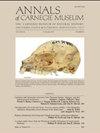A Unique Rodent Fauna from the Whitneyan (Middle Oligocene) of Southwestern Montana
IF 0.9
4区 地球科学
Q4 PALEONTOLOGY
引用次数: 6
Abstract
ABSTRACT Nine rodents are described from the Whitneyan (middle Oligocene) White Hills fauna of Montana. Of these, three new genera are described: the aplodontid Altasciurus, the cylindrodontid Lophicylindrodon, and the castorid Montanacastor. Prosciurus relictus (Cope, 1873) is named as the type species of Altasciurus. The other genera are unique to this fauna and are based on new species; Lophicylindrodon expiratus and Montanacastor simplicidens. In addition, two more new species are described: the eomyid Orelladjidaumo exiguus and the cricetid Willeumys argosorus. The rodent fauna from White Hills is believed to be Whitneyan in age because of the occurrence of Eumys brachyodus Wood, 1937, and Leptodontomys douglassi (Burke, 1934); both elsewhere known from the Whitneyan. The rodent fauna is unique for several reasons: 1) a much lower diversity of rodents than in comparably aged faunas; 2) the number of unique species (four of nine); 3) the relict occurrence of a cylindrodontid (otherwise latest occurrence in the Chadronian); and 4) the extremely high proportion of a single species (A. relictus makes up over 70% of the number of specimens in the fauna). The uniqueness of this fauna may be explained by the fact that the other well-known Whitneyan faunas are from the Great Plains, whereas the White Hills fauna was likely from an isolated intermountain basin. However, taphonomic factors may have controlled the relative numbers of specimens of each species.蒙大拿西南部惠特尼岩(中渐新世)独特的啮齿动物区系
摘要报道了蒙大拿州怀特山Whitneyan(中渐新世)动物群中的9只啮齿动物。其中,描述了3个新属:拟龙属Altasciurus,柱龙属Lophicylindrodon和castorid Montanacastor。Prosciurus relictus (Cope, 1873)被命名为Altasciurus的模式种。其他属是这个动物群所特有的,是基于新种的;吐口水龙与单口水龙。此外,还发现了2个新种:拟卵类Orelladjidaumo exiguus和拟蟋蟀Willeumys argosorus。由于发现了Eumys brachyodus Wood(1937)和Leptodontomys douglassi (Burke, 1934), White Hills的啮齿动物群被认为是Whitneyan年龄;都是从惠特尼岩中发现的啮齿动物区系之所以独特,有以下几个原因:1)啮齿动物的多样性远低于同等年龄的动物区系;2)独特物种的数量(9个中的4个);3)柱状骨柱的残余(否则是在乍得纪最近出现的);(4)单一物种所占比例极高(沙蚕占动物区系标本总数的70%以上)。这种动物群的独特性可以用这样一个事实来解释:其他著名的惠特尼动物群来自大平原,而怀特山动物群可能来自一个孤立的山间盆地。然而,地理因素可能控制了每个物种标本的相对数量。
本文章由计算机程序翻译,如有差异,请以英文原文为准。
求助全文
约1分钟内获得全文
求助全文
来源期刊

Annals of Carnegie Museum
综合性期刊-动物学
CiteScore
2.50
自引率
18.20%
发文量
4
审稿时长
>12 weeks
期刊介绍:
Annals of Carnegie Museum is a quarterly journal that publishes peer-reviewed short and medium-length original scientific contributions in organismal biology, earth sciences, and anthropology, in 40 by 52.5 pica format (168 by 220 mm or 6-5/8 by 8-5/8 inches). Subject matter must be relevant to Carnegie Museum of Natural History scientific sections or Powdermill Nature Reserve (PNR), preferably with connection to the Carnegie collection and/or personnel. Carnegie Museum staff and research associates receive publication priority, but others are encouraged to submit papers, especially those manuscripts explicitly based on the Carnegie collection.
 求助内容:
求助内容: 应助结果提醒方式:
应助结果提醒方式:


